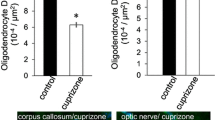Summary
Neuronal hypertrophy and increased metabolism in nerve cells are evaluated as possible factors initiating hyperplasia of perineuronal cells. Colchicine induced neuropathy in the dorsal root ganglia is used as the model of increased neuronal metabolism.
Twenty-eight female white rats weighing 100 g were divided into four groups, each animal receiving a 50 μl injection into the subarachnoid space at the lumbosacral level eight days and again three days before sacrifice. The 50 μl contained 25, 2.5 and 0.25 μg of colchicine in distilled water for the first three groups and normal saline for the last group.
A Zeiss ocular with random test points was used to determine the volume of tissue occupied by perineuronal cells and nerve cells in spinal ganglia. Direct cell counts yielded the size of the population of perineuronal cells and neurons.
Irreversible motor and sensory loss occurred with the high dose injection, reversible loss with the 2.5 μg injection and no loss with either the low dose or the saline injection. Chromatolytic neurons were noted in all animals receiving colchicine. Neither proliferation of perineuronal cells nor neuronal hypertrophy were observed. Neuronal hypertrophy, rather than altered neuronal metabolism, may be the initiating event in the perineuronal cell hyperplasia that frequently accompanies chromatolysis.
Similar content being viewed by others
References
Bodian, D., Mellors, R. C.: The regenerative cycle of motor neurons with special reference to phosphatase activity. J. exp. Med. 81, 469–487 (1945).
Brattgård, S. O., Edström, J. E., Hyden, H.: The chemical changes in regenerating neurons. J. Neurochem. 1, 316–325 (1957).
Carmel, P. W., Stein, B. M.: Cell changes in sensory ganglia following proximal and distal nerve section in the monkey. J. comp. Neurol. 135, 145–165 (1969).
Edström, J. E.: Ribonucleic acid changes in the motoneurons of the frog during axon regeneration. J. Neurochem. 5, 43–49 (1959).
Embree, L. J., Hamberger, A., Sjöstrand, J.: Quantitative cytochemical studies and histochemistry in experimental neurofibrillary degeneration. J. Neuropath. exp. Neurol. 26, 427–436 (1967).
Friede, R. L., Johnstone, M. A.: Response of thymidine labeling of nuclei in gray matter and nerve following sciatic transection. Acta neuropath. (Berl.) 7, 218–231 (1967).
Hamberger, A.: Difference between isolated neuronal and vascular glia with respect to respiratory activity. Acta physiol. scand. 58, Suppl. 203, 1–58 (1963).
—, Sjöstrand, J.: Respiratory enzyme activities in neurons and glial cells of the hypoglossal nucleus during nerve regeneration. Acta physiol. scand. 67, 76–88 (1966).
Hugosson, R., Källen, B., Nilsson, O.: Neuroglia proliferation studied in tissue culture. Acta neuropath. (Berl.) 11, 210–220 (1968).
Humbertson, A., Zimmerman, E., Leedy, M.: A chronological study of mitotic activity in satellite cell hyperplasia associated with chromatolytic neurons. Z. Zellforsch. 100, 507–515 (1969).
Klatzo, I., Wisniewski, H., Streicher, E.: Experimental production of neurofibrillary degeneration. I. Light microscopic observations. J. Neuropath. exp. Neurol. 24, 187–199 (1965).
Konigsmark, B. W., Sidman, R. L.: Origin of brain macrophages in the mouse. J. Neuropath. Exp. Neurol. 22, 643–676 (1963).
Kreutzberg, G. W.: Changes of coenzyme (TPN) diaphorase and TPN-linked dehydrogenase during axonal reaction of the nerve cell. Nature (Lond.) 199, 393–394 (1963).
Pannese, E.: Investigations on the ultrastructural changes of the spinal ganglion neurons in the course of axon regeneration and neuronal hypertrophy. I. Changes during axon regeneration. Z. Zellforsch. 60, 711–740 (1963a).
—: Investigations on the ultrastructural changes of the spinal ganglion neurons in the course of axon regeneration and neuron hypertrophy. II. Changes during cell hypertrophy and comparison between the ultrastructure of nerve cells of the same type under different functional conditions. Z. Zellforsch. 61, 561–585 (1963b).
—: Number and structure of perisomatic satellite cells of spinal ganglia under normal conditions or during axon regeneration and cell hypertrophy. Z.Zellforsch. 63, 568–592 (1964).
Peterson, E., Murray, M.: Serial observations in tissue cultures on neurotoxic effects of colchicine. Anat. Rec. 154, 401 (1966).
Schwyn, R. C.: An autoradiographic study of satellite cells in autonomic ganglia. Amer. J. Anat. 121, 727–740 (1967).
Sjöstrand, J.: DNA synthesis in glial cells during nerve regeneration. Experientia (Basel) 21, 142–143 (1965).
—: Glial cells in the hypoglossal nucleus of the rabbit during nerve regeneration. Acta physiol. scand. 67, Suppl. 270, 1–43 (1966).
Smith, M. L., Adrian, E. K.: Infiltration of prelabeled mononuclear cells into dorsal root ganglia following transection of the sciatic nerve. Anat. Rec. 166, 380 (1970).
Terry, R. D., Pena, C.: Experimental production of neurofibrillary degeneration. II. Electron microscopy, phosphatase histochemistry and electron probe analysis. J. Neuropath. exp. Neurol. 24, 200–210 (1965).
Torvik, A., Heding, A.: Histological studies on the effects of actinomycin D on retrograde nerve cell reaction in the facial nucleus of mice. Acta neuropath. (Berl.) 9, 146–157 (1967).
—: Effect of actinomycin D on retrograde nerve cell reaction further observations. Acta neuropath. (Berl.) 14, 62–71 (1969).
Watson, W. E.: An autoradiographic study of the incorporation of nucleic-acid precursors by neurones and glia during nerve regeneration. J. Physiol. (Lond.) 180, 741–753 (1965a).
—: An autoradiographic study of the incorporation of nucleic-acid precursors by neurones and glia during nerve stimulation. J. Physiol. (Lond.) 180, 754–765 (1965b).
Wisniewski, H., Terry, R. D.: Experimental colchicine encephalopathy. I. Induction of neurofibrillary degeneration. Lab. Invest. 17, 577–587 (1967).
—, Shelanski, M. L., Terry, R. D.: Effects of mitotic spindle inhibitors on neurotubules and neurofilaments in anterior horn cells. J. Cell Biol. 38, 224–229 (1968).
Author information
Authors and Affiliations
Rights and permissions
About this article
Cite this article
Zimmerman, E., Karsh, D. & Humbertson, A. Initiating factors in perineuronal cell hyperplasia associated with chromatolytic neurons. Z. Zellforsch. 114, 73–82 (1971). https://doi.org/10.1007/BF00339466
Issue Date:
DOI: https://doi.org/10.1007/BF00339466




